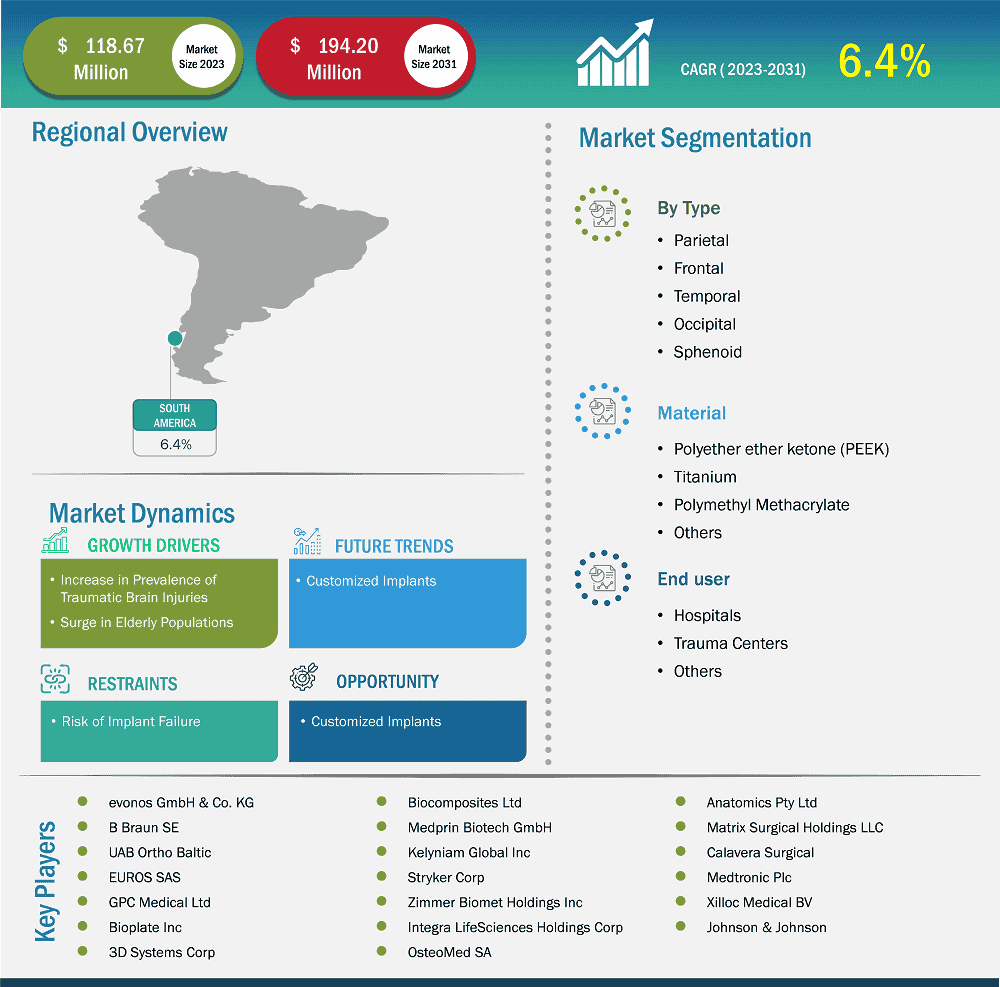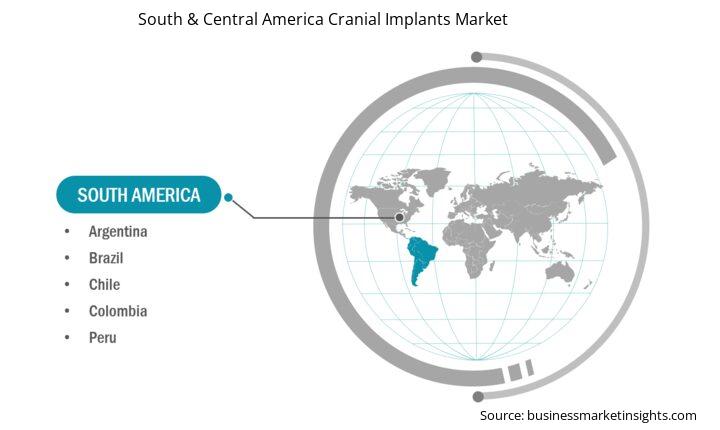South & Central America Cranial Implants Market Report (2021-2031) by Scope, Segmentation, Dynamics, and Competitive Analysis.
No. of Pages: 190 | Report Code: BMIRE00031984 | Category: Life Sciences
No. of Pages: 190 | Report Code: BMIRE00031984 | Category: Life Sciences
The South & Central America cranial implants market size is expected to reach US$ 194.20 million by 2031 from US$ 118.67 million in 2023. The market is estimated to record a CAGR of 6.4% from 2023 to 2031.
The cranial implants market in South & Central America is segmented into Brazil, Argentina, and the Rest of South & Central America. The market growth in this region is attributed to flourishing healthcare infrastructure, an increasing aging population, and growing cases of neurological diseases. Rising healthcare investments and improved access to medical facilities also contribute to the market's expansion. Increased awareness of cranial implant benefits among healthcare professionals and patients also plays a crucial role in fostering demand, further supporting market growth.
South & Central America Cranial Implants Market Strategic Insights

South & Central America Cranial Implants Market Segmentation Analysis
Key segments that contributed to the derivation of the South & Central America cranial implants market analysis are type, material, and application.
3D printing, also known as additive manufacturing, allows for the creation of highly customized, patient-specific cranial implants that offer improved fitness and functionality compared to traditional implants. The design and production of cranial implants have evolved with progress in this technology, enabling precise replication of an individual’s skull geometry, which reduces the risk of surgical complications and enhances recovery outcomes. The integration of multilayer technology in 3D printing further enhances these benefits. This technology enables the creation of implants with multiple layers; each designed with different properties tailored to specific functions. For instance, one layer might be engineered for structural strength, while another could focus on biocompatibility or flexibility. Multilayered 3D-printed implants can improve osseointegration (bone growth into the implant), reduce the risk of implant rejection, and offer superior protection for the brain.
3D printing allows for faster production times, lower manufacturing costs, and greater flexibility in adapting to complex cranial deformities. These advancements not only improve patient outcomes but also reduce the overall cost of treatment, making cranial implants more accessible to a broader patient population. As a result, advancements in 3D printing with the integration of original multilayer technology, offering improved surgical precision, reduced complications, and better long-term performance, present significant opportunities for the cranial implant market.
Based on country, the South & Central America cranial implants market comprises Brazil, Argentina, and the Rest of South & Central America. Brazil held the largest share in 2023.
According to the Pan American Health Organization, Brazil had more than 30 million older adults aged 60 and above as of 2022, representing 13% of the country's population. By 2030, the number of people from this age group will reach nearly 50 million, which will be 24% of its total population. The WHO and the Brazilian Institute of Geography and Statistics reported that the geriatric population in the country (aged 60 years and older) is expected to reach ~55 million by 2040. The prevalence of a few neurological diseases is associated with the aging population. Thus, the demand for cranial implants rises with population aging, which is associated with the increased prevalence of neurological disorders and higher rates of TBIs from falls. As older adults seek improved treatment options to enhance their quality of life, advancements in cranial implant technology make these solutions more accessible. According to the study; Traumatic Brain Injury Hospital Incidence in Brazil: An Analysis of the Past 10 Years, published in 2021, 131,014 hospital admissions associated with TBIs were observed on an average per year during 2008–2019 in the country. As TBI cases rise due to accidents and falls, the requirement for protective and reconstructive solutions becomes essential. Cranial implants offer effective restoration of skull integrity and brain protection, leading to increased adoption in clinical settings to enhance recovery outcomes for TBI patients.
South & Central America Cranial Implants Market Report Highlights
Report Attribute
Details
Market size in 2023
US$ 118.67 Million
Market Size by 2031
US$ 194.20 Million
CAGR (2023 - 2031) 6.4%
Historical Data
2021-2022
Forecast period
2024-2031
Segments Covered
By Type
By Material
By End User
Regions and Countries Covered
South and Central America
Market leaders and key company profiles
South & Central America Cranial Implants Market Company Profiles
Some of the key players operating in the market include Stryker Corp, Zimmer Biomet Holdings Inc, Integra LifeSciences Holdings Corp, OsteoMed SA, Anatomics Pty Ltd, Matrix Surgical Holdings LLC, Calavera Surgical, Medtronic Plc, Xilloc Medical BV, Johnson & Johnson, evonos GmbH & Co. KG, B Braun SE, UAB Ortho Baltic, 3D Systems Corp, GPC Medical Ltd, Bioplate Inc, EUROS SAS, Biocomposites Ltd, Medprin Biotech GmbH, Kelyniam Global Inc, MedCAD, KLS Martin Group, and Longeviti Neuro Solutions LLC, among others. These players are adopting various strategies such as expansion, product innovation, and mergers and acquisitions to provide innovative products to their consumers and increase their market share.
The following methodology has been followed for the collection and analysis of data presented in this report:
The research process begins with comprehensive secondary research, utilizing both internal and external sources to gather qualitative and quantitative data for each market. Commonly referenced secondary research sources include, but are not limited to:
Note: All financial data included in the Company Profiles section has been standardized to USD. For companies reporting in other currencies, figures have been converted to USD using the relevant exchange rates for the corresponding year.
The Insight Partners conducts a significant number of primary interviews each year with industry stakeholders and experts to validate its data analysis and gain valuable insights. These research interviews are designed to:
Primary research is conducted via email interactions and telephone interviews, encompassing various markets, categories, segments, and sub-segments across different regions. Participants typically include:

The South & Central America Cranial Implants Market is valued at US$ 118.67 Million in 2023, it is projected to reach US$ 194.20 Million by 2031.
As per our report South & Central America Cranial Implants Market, the market size is valued at US$ 118.67 Million in 2023, projecting it to reach US$ 194.20 Million by 2031. This translates to a CAGR of approximately 6.4% during the forecast period.
The South & Central America Cranial Implants Market report typically cover these key segments-
The historic period, base year, and forecast period can vary slightly depending on the specific market research report. However, for the South & Central America Cranial Implants Market report:
The South & Central America Cranial Implants Market is populated by several key players, each contributing to its growth and innovation. Some of the major players include:
The South & Central America Cranial Implants Market report is valuable for diverse stakeholders, including:
Essentially, anyone involved in or considering involvement in the South & Central America Cranial Implants Market value chain can benefit from the information contained in a comprehensive market report.